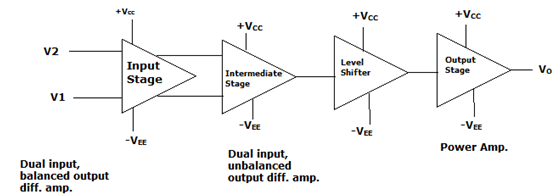This set of Analog Circuits Multiple Choice Questions & Answers (MCQs) focuses on “Operational Amplifiers”.
1. Which of these is incorrect for an operational amplifier?
a) It has a high voltage gain
b) It is a direct coupled amplifier
c) It is only useful for amplifying AC signals
d) It was originally designed to perform mathematical operations
View Answer
Explanation: Operational amplifier is a high voltage gain, direct coupled amplifier which can be used to perform mathematical operations on analog signals. It can be used to amplify both DC and AC signals.
2. In the given block diagram of an op-amp. What are A, B, C and D?

a) A = Dual input and balanced output differential amplifier, B = Dual input and unbalanced output differential amplifier, C = Level shifter, D = Power amplifier
b) A = Dual input and balanced output differential amplifier, B = Dual input and balanced output differential amplifier, C = Dual input and unbalanced output differential amplifier, D = Normal amplifier
c) A = Dual input and unbalanced output differential amplifier, B = Dual input and balanced output differential amplifier, C = Voltage regulator, D = Power amplifier
d) A = Normal amplifier, B = Dual input and unbalanced output differential amplifier, C = Level shifter, D = Dual input and balanced output differential amplifier
View Answer
3. In an ideal op-amp, which is not true?
a) Open loop voltage gain is infinite
b) Input resistance is infinite
c) Slew rate is infinite
d) CMRR is zero
View Answer
Explanation: For an ideal op-amp, the open loop voltage gain is infinite. The output resistance is 0 and the input resistance is infinite. Op-amp has zero input current, zero offset voltage, infinite bandwidth, infinite CMRR and infinite slew rate.
4. A practical op-amp has a bandwidth of only 10 Hz. Gain is 106, and the required bandwidth is 100 kHz. How much feedback is required?
a) 0.99% negative feedback
b) 0.99% positive feedback
c) 1% negative feedback
d) 1% positive feedback
View Answer
Explanation: B2 = B1(1+βA) = 10(1+β106) = 100k
1 + β106 = 10k
β = 9.999×10-3
In percentage, feedback β = 0.99% negative feedback.
5. Given that for an op-amp the gain is 103, the slew rate is 1.5V/μsec. Input is 5×10-3sinωt, calculate maximum frequency to prevent distortion.
a) 47.7 kHz
b) 0.3 MHz
c) 477 Hz
d) 3 kHz
View Answer
Explanation: dVOUT(max)/dT =< Slew rate
A.Vmω =< 1.5 V/μsec
103.5.10-3.ω = < 1.5×106
ω=<0.3×106
Frequency f = 0.0477×106Hz.
6. Given that CMRR is 100dB. Input common-mode voltage is 12 V. Differential voltage gain is 4000. Calculate output common-mode voltage.
a) 48V
b) 0.48V
c) 20V
d) 11V
View Answer
Explanation: CMRR = 20 log(AD/ACM) = 20 log(4000×12/Vocm) = 100
Log(48000/VOCM) = 5
48000/VOCM = 105
VOCM = 0.48V.
7. The unity gain bandwidth for an op-amp having open loop gain 2×106 is 10 Mhz. Calculate the AC gain of op-amp at an input of 2000 Hz.
a) 2000
b) 5000
c) 10000
d) 12.5
View Answer
Explanation: UGB = AOLfOL
fOL = 10M/2×106 = 5Hz
The AC gain |A| = \(\frac{AOL}{\sqrt{1+(f/5)^2}}\)
|A| = 2×106/400 = 5000.
8. Which of the following option is correct according to the below statements?
A: Voltage gain of op-amp decreases at high frequencies B: Its internal structure uses a capacitor
a) Both A and B are correct, and B is the correct reason for A
b) Both A and B are correct, but B is not the correct reason for A
c) A is correct and B is incorrect
d) A is incorrect and B is correct
View Answer
Explanation: The internal structure of an op-amp uses a compensation capacitor for stability purpose. It provides dominant pole compensation; thereby the op-amp remains stable. However, the op-amp gain remains constant at low frequencies but decreases at high frequencies due to a compensation capacitor.
9. Till what frequency do we get amplification from IC 741?
a) Unity gain bandwidth
b) 3-dB frequency
c) Infinity
d) UGB + fOL
View Answer
Explanation: The 3dB frequency is the cut-off frequency, where the gain is \(\frac{1}{\sqrt{2}}\) of the maximum. The gain is only constant for infinite frequency, that is, has infinite bandwidth if the op-amp is ideal, which practically doesn’t exist. The UGB is the point at which the gain of op-amp reaches 1.
10. What is the use of the compensation capacitor in op-amp?
a) Improves the amplification of op-amp
b) Decreases the slew rate of op-amp
c) Increases the bandwidth of op-amp
d) Op-amp acts as all pass filter
View Answer
Explanation: Compensation capacitor in the internal structure of op-amp to improve its frequency response, increasing its stability. It also decreases the slew rate of the op-amp.
Sanfoundry Global Education & Learning Series – Analog Circuits.
To practice all areas of Analog Circuits, here is complete set of 1000+ Multiple Choice Questions and Answers.
If you find a mistake in question / option / answer, kindly take a screenshot and email to [email protected]

